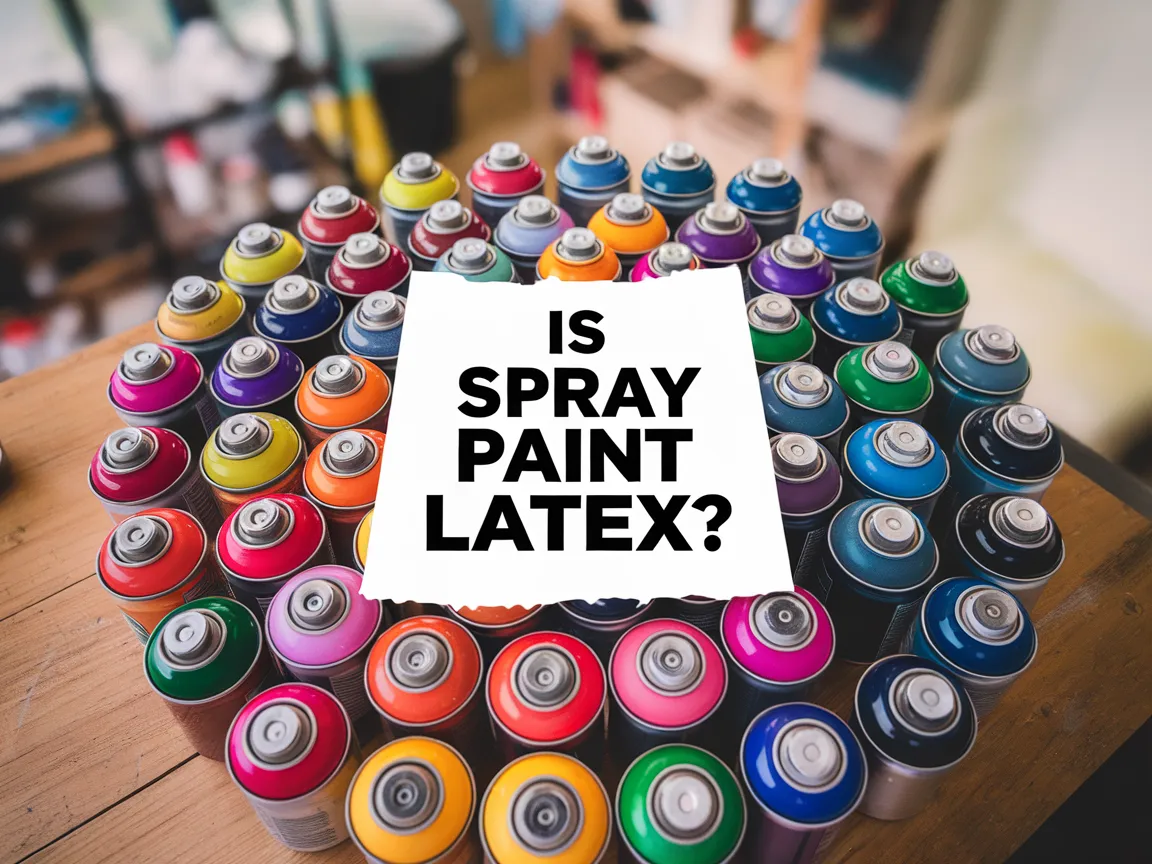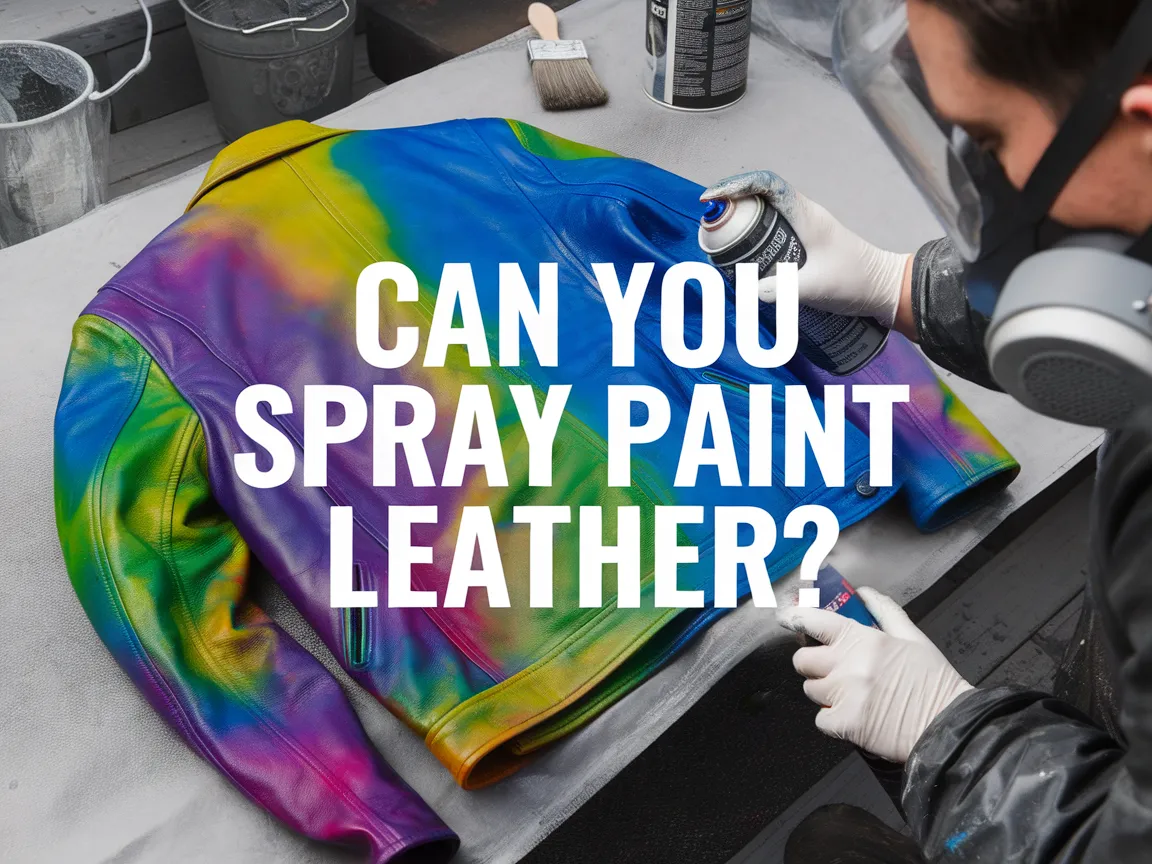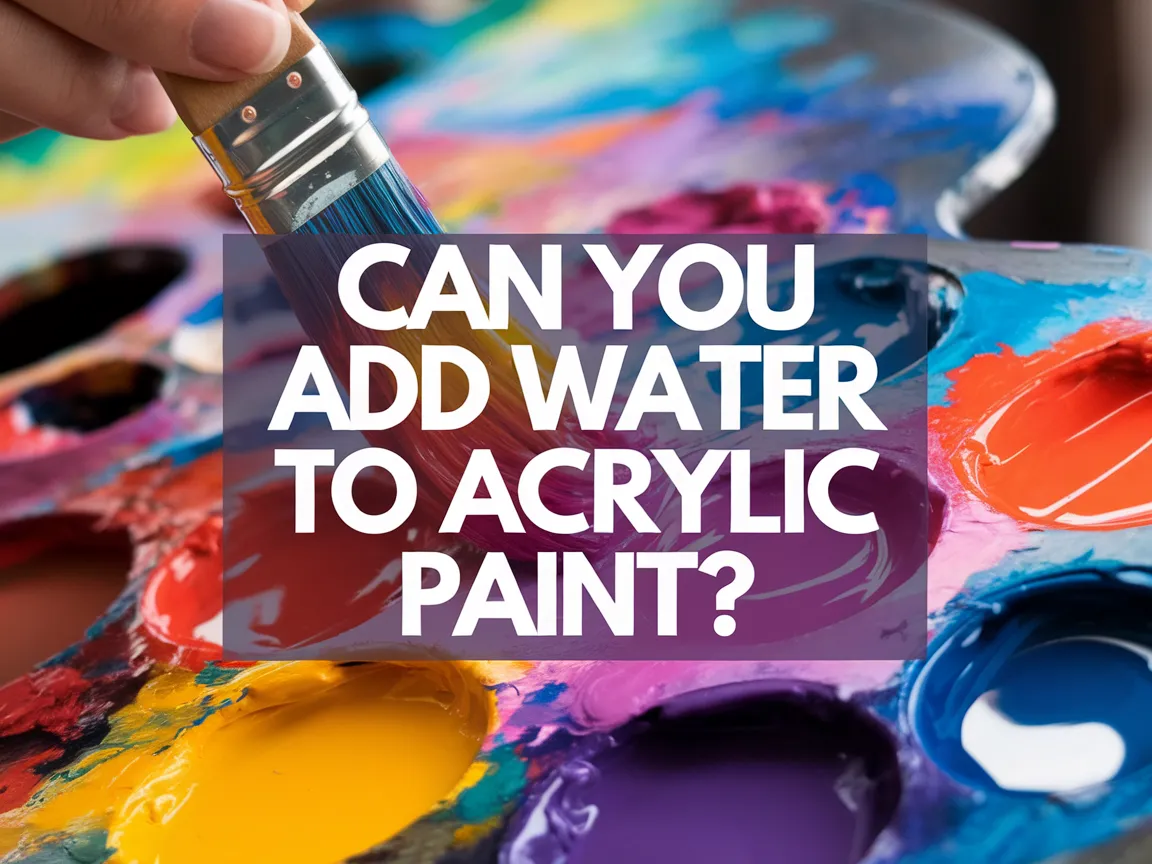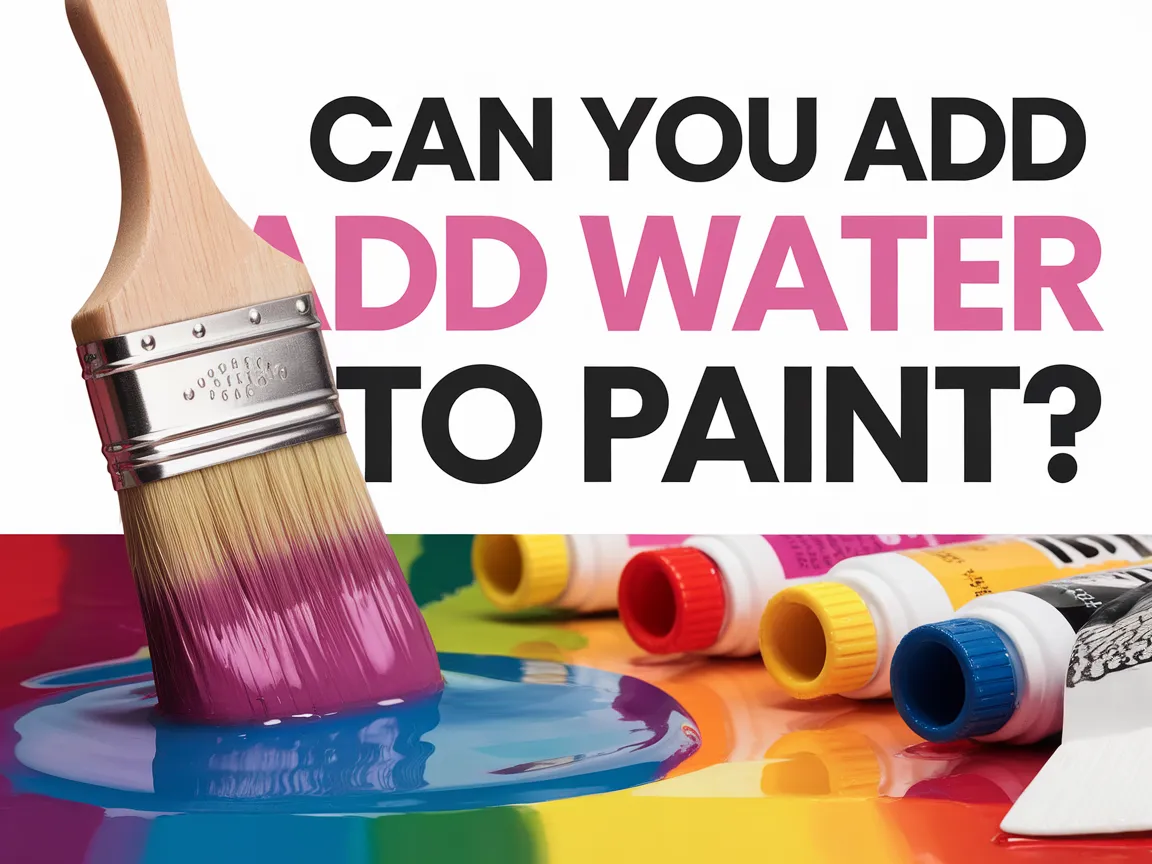Can Acrylic Paint Be Used for A Mural?
Published on: February 20, 2025 | Last Updated: January 7, 2025
Written By: Alisha Winters
A mural is a big painting on a wall, like a giant picture that tells a story. It can make a place bright and happy!
You might wonder, can acrylic paint techniques for murals make all the difference? This question’s super important, because choosing the right paint makes all the difference. I’ve tried different types of paint before, and trust me, the right one makes your work shine!
In this article, we’ll dive into what murals are, discuss the essential steps for painting one, explore suitable acrylic paints, share color palette tips, and even cover common issues and solutions. You’ll also find answers to questions like can you use acrylic paint on fabric, and why did Jackson Pollock paint number 5?
Contents
- 1 Can Acrylic Paint Be Used for a Mural?
- 2 What is a Mural?
- 3 Before You Start Painting a Mural
- 4 Steps to Create a Stunning Mural
- 5 Recommended Color Palette for Murals
- 6 Benefits of Using Acrylic Paint for Murals
- 7 Comparing Acrylic Paint to Other Types for Murals
- 8 Types Of Acrylic Paint Suitable for Murals
- 9 Factors Affecting Mural Durability With Acrylic Paint
- 10 Common Issues When Using Acrylic Paint for Murals
- 11 Finishing Touches: Sealing and Protecting Your Mural
- 12 Maintenance Tips for Acrylic Paint Murals
- 13 Understanding the Environmental Impact of Acrylic Paint
- 14 Frequently Asked Questions
- 15 Conclusion
- 16 Additional Resources
Can Acrylic Paint Be Used for a Mural?
Absolutely! Acrylic paint works great for murals. It’s durable, dries fast, and is versatile on various surfaces. Plus, you can even mix it with mediums for different finishes!
The Finishing Touch
A freshly painted wall is a blank canvas. The best way to bring your room to life is with a single piece of statement art that ties everything together.
Browse Wall Art at Big Wall DecorWhat is a Mural?
A mural is large-scale artwork painted directly on walls, ceilings, or other surfaces. Typically using durable outdoor paint, murals can cover areas up to 5,000 square feet (465 M²) or more, allowing for immense creativity and expression.
Can acrylic paint be used for a mural? In my experience, choosing the right painting medium is crucial for great results. I once painted a mural with acrylic, and it brought the colors to life in the sun. If you’re curious about mixing vibrant colors for your artwork, you might want to explore how to create perfect paint blends.
I’ve used it to create vibrant community murals. Painting with acrylic let me explore intricate designs and was surprisingly easy to wash off my hands! It made me think about selecting the right materials—like when I needed to mix polyurethane with paint for durability. When working with different surfaces like aluminum, I discovered specific painting techniques that ensure better adhesion and finish painting aluminum requires special preparation.
Before You Start Painting a Mural
What do you need to get started?
- Acrylic Paint: Use high-quality acrylic paint, such as Liquitex Basics or Golden Heavy Body. These brands offer excellent coverage and durability, essential for lasting outdoor murals.
- Primer: Choose a good primer like Zinsser Bulls Eye or Rust-Oleum Professional. A solid primer seals the surface and enhances paint adhesion, reducing peeling and fading.
- Brushes and Rollers: Stock up on various sizes of brushes (Like Princeton Velvetouch) and rollers (Purdy White Dove). Different tools give you complete control over detail and coverage.
- Easel or Scaffold: Use an easel (If Your Mural is Small) or scaffolding (For Larger Projects) to ensure stability and precise painting at a comfortable height.
That covers essential tips before starting your mural. Let’s now take a look at the steps to create a stunning mural.
Also See: What Kind Of Paint Did Bob Ross Use? Find Out Here!

The Finishing Touch
A freshly painted wall is a blank canvas. The best way to bring your room to life is with a single piece of statement art that ties everything together.
Browse Wall Art at Big Wall DecorSteps to Create a Stunning Mural
Here are the steps for using acrylic paint on your mural project!
-
Choosing the Right Surface
Select a smooth wall that’s clean and properly primed. A treated surface ensures better adhesion and longevity, reducing peeling.
Consider textures too! For indoor murals, drywall is best, while cement board or treated wood works well outdoors. Aim for a surface temperature between 10°C (50°F) and 29°C (85°F) for optimal painting conditions. If you’re working with specialized materials like aluminum, you might want to explore painting aluminum surfaces effectively.
-
Preparing for the Base Coat
Use a roller or spray primer for your base coat. A white or light color helps the acrylic paints pop.
Allow the base coat to dry completely—this takes about 1 to 2 hours. Proper preparation prevents paint from soaking into porous surfaces.
-
Sketching Your Design
Lightly sketch your design onto the prepared surface using chalk or pencil. Start with rough outlines; you’ll refine details while painting.
Check proportions! Use techniques like the grid method for accuracy. The sketch phase is your visual guide as you layer paint on the wall.
-
Applying Acrylic Layers
Start with broad sections using large brushes or rollers. Thin your acrylic paint slightly with water for a smooth application, as it dries quickly.
Layering is key! Let each layer dry before adding another coat. Most acrylic paints dry in 20 to 30 minutes at room temperature (20°C or 68°F).
-
Detailing and Texturing
Add personality with bold strokes and creative touches. Use smaller brushes for intricate details or sponges for textures to enhance depth.
Experiment! You can mix acrylic paints with mediums for effects like gloss or metallic finishes. Test mixes on scraps to visualize the final look before applying them to the mural.
-
Sealing the Mural
Let the mural cure for 24 to 48 hours, then seal it with a protective finish. Use an acrylic-based varnish to enhance colors and provide a waterproof barrier.
Apply multiple light coats to prevent drips. A spray varnish works best for even coverage. Try to apply the sealant in drier conditions for proper curing.
We have now covered the steps to create a stunning mural. Next, we will explore a recommended color palette for murals.
Recommended Color Palette for Murals
I recommend a vibrant Tropical Escape palette for your mural, as it brings life and energy to any space with its harmonious colors.
| Color Box | Hex Code | Color Name |
|---|---|---|
| #FF6F61 | ||
| #6FBF78 | ||
| #F7C94C | ||
| #6FB3F3 | ||
| #ED84C5 |
You should now have a good understanding of suitable color palettes for murals. In the next part, we’ll discuss advantages of acrylic paint for murals.
Benefits of Using Acrylic Paint for Murals
Acrylic paint is your go-to choice for murals, and here’s why!
-
Fast Drying Time
Acrylic paint dries quickly, usually within 20 to 30 minutes (at room temperature, 20°C or 68°F). This means you can paint multiple layers in a single day!
-
Weather Resistance
It’s resistant to rain and UV rays, making it suitable for outdoor murals. Quality acrylics can last 5 to 10 years—even longer with proper sealing!
-
Vibrant Colors
The color payoff is stunning! Acrylics maintain their brilliance, and you can mix and match shades to create unique hues.
-
Easy Cleanup
Cleanup is a breeze! Just use soap and water before the paint dries. That’s a win for your workspace.
-
Versatility
Acrylic paint works on various surfaces—brick, wood, and concrete. You can create murals on indoor or outdoor walls with ease!
We have now covered the advantages of using acrylic paint for murals. Next, we will compare acrylic paint to other types.

Comparing Acrylic Paint to Other Types for Murals
Not sure if acrylic is your best option? Let’s compare it to other paint types.
| Type of Paint | Drying Time | Durability | Color Vibrance | Moisture Resistance |
|---|---|---|---|---|
| Acrylic | 20-30 minutes | High | Very High | Excellent |
| Oil-Based | 6-8 hours | Very High | High | Good |
| Spray Paint | 5-10 minutes | Medium | High | Variable |
| Latex Paint | 1-2 hours | Medium | Medium | Variable |
Types Of Acrylic Paint Suitable for Murals
Let’s explore the different types: Artist-grade, Student-grade, Heavy-body, Fluid, and Interactive.
-
Artist-grade Acrylics
These high-quality paints have a pigment load of up to 70%. They’re vibrant, lightfast, and last for years on murals, making them an excellent choice for outdoor projects.
-
Student-grade Acrylics
These affordably priced paints have a lower pigment concentration (Around 40-50%). While less vibrant, they’re a solid option for practice and large murals with less intricate detail.
-
Heavy-body Acrylics
These thick paints maintain their shape and texture, making them perfect for creating relief effects and 3D elements that pop off the wall.
-
Fluid Acrylics
Fluid acrylics have a runny consistency, ideal for blending and washes. They easily cover large areas, blurring the line between painting and dyeing.
-
Interactive Acrylics
These unique paints can be reactivated with water after application. Use them to create layers and achieve different effects in your mural.
Through trial and error, I’ve found that Artist-grade acrylics work best for my murals. Their longevity and vibrant colors leave a lasting impression!
Factors Affecting Mural Durability With Acrylic Paint
What factors influence the use of acrylic paint for murals?
-
Surface Preparation: Proper preparation ensures adhesion and longevity of the acrylic paint.
-
Climate Conditions: Extreme temperatures can damage murals and reduce the durability of acrylic paint.
-
Paint Quality: High-quality acrylics resist fading and wear, enhancing mural durability.
-
Sealing Technique: A good sealant protects murals from moisture and UV damage, extending their life.
Common Issues When Using Acrylic Paint for Murals
When my friend decided to paint a mural, she wondered, “Can acrylic paint be used for a mural?” One challenge was that the paint dried too quickly in the sun, causing uneven layers.
The Finishing Touch
A freshly painted wall is a blank canvas. The best way to bring your room to life is with a single piece of statement art that ties everything together.
Browse Wall Art at Big Wall DecorTo fix this, she used a mixture with 15% retarder (A Substance That Slows Drying). It extended the drying time, allowing the layers to blend smoothly. She also prepped the surface well to ensure adhesion and reduce fading.
Finishing Touches: Sealing and Protecting Your Mural
After painting a mural with acrylics, seal it with a UV-resistant varnish. Use a product like Liquitex UV Protect or similar sprays that cure in 24 hours for lasting protection.
Time for inspection! Check for any potential flaking at least twice a year. Inspect areas of about 1 square meter (10.76 Ft²) for signs of wear, especially where sun exposure is high.
If this isn’t your first mural, consider applying a second layer of varnish within three months. This bolsters protection against environmental elements while enhancing color vibrancy.
Maintenance Tips for Acrylic Paint Murals
Keeping your mural fresh is vital for its longevity. Here’s how to care for your artwork!
-
Regular Cleaning
Dust the mural gently with a soft cloth. Avoid harsh chemicals! Just a mix of mild soap and water works wonders.
-
Inspect for Damage
Check your mural every few months for any signs of peeling, fading, or damage. Look closely, especially in high-sun areas!
-
Reapply Sealant
Once a year, apply a fresh coat of UV-resistant varnish to maintain that vibrant look and safeguard against UV rays and moisture.
-
Touch-Up as Needed
Keep some of your original paint for touch-ups. It’s best to address any scratches or fades promptly to keep your mural looking its best!
Understanding the Environmental Impact of Acrylic Paint
Acrylic paint is popular, but what about its environmental footprint?
-
Water-Based Composition
Acrylic paints are typically water-based, making them less hazardous to the environment than oil paints. They reduce the release of harmful solvents!
-
Low VOC Levels
Most acrylic paints have low levels of volatile organic compounds (VOCs). This means fewer harmful emissions when compared to traditional oil paints.
-
Recycling Options
Check if your local program accepts acrylic paint for recycling. Proper disposal helps reduce waste and protect the environment.
Frequently Asked Questions
Can I Use Acrylic Paint on Outdoor Murals?
Yes, you can use acrylic paint for outdoor murals. Acrylic paint is durable and dries quickly, making it ideal for various weather conditions, which are critical for outdoor applications. However, you must choose exterior-grade acrylics with UV protection for longevity.
How Long Does Acrylic Paint Last on a Mural?
Acrylic paint can last for 5 to 10 years on a mural. Factors influencing its lifespan include sun exposure, weather elements, and the quality of the paint used. High-quality professional grade acrylic can enhance durability significantly. Researchers have long studied the preservation techniques of artistic surfaces, with some fascinating parallels to ancient prehistoric cave painting techniques.
What Tools Do I Need for Painting a Mural?
You’ll need various tools for painting a mural, such as brushes, rollers, and spray bottles. The size of your mural will dictate the proportions of each tool; for large areas, use wide rollers, while detail work needs finer brushes. If you’re interested in digital art techniques, you might want to explore how digital painting animation works.
Can I Mix Acrylic Paint Colors for My Mural?
Yes, you can mix acrylic paint colors for your mural. Mixing allows you to create unique shades tailored to your design. To maintain consistency, use the same brand and type of acrylic paints for the best results. If you’re working on an exterior project, you might want to explore painting aluminum window frames with similar techniques.
How to Fix Mistakes When Painting a Mural?
You can fix mistakes when painting a mural by using water or a damp cloth for minor errors. For larger mistakes, scrape off the paint layer and touch up with the correct color. Act quickly for the best outcome.
Can I Add Mod Podge to Acrylic Paint?
Yes, you can add Mod Podge to acrylic paint. Mixing Mod Podge with acrylic paint enhances durability while applying a protective finish. It’s perfect for crafts and artistic projects, giving your piece a nice sheen. If you’re looking to explore more painting techniques, painting exterior surfaces requires similar protective strategies.
Can You Paint Fabric With Acrylic Paint?
Yes, you can paint fabric with acrylic paint. Use a fabric medium to improve flexibility and reduce cracking. Additionally, fix your painted fabric with heat after drying to set the color.
What Filler Can You Paint Over With Acrylic Paint?
You can paint over latex fillers with acrylic paint. Latex fillers adhere well without causing contamination issues, which enables a smooth surface for your acrylic application. Ensure it’s fully cured for the best results! When working with 3D printed objects, you might want to explore painting techniques for printed models.
Also See: Can You Paint Oil-based Paint Over Oil-based Paint?
Conclusion
We covered what a mural is, preparations before painting, steps for a stunning mural, color palettes, suitable types of acrylic paint, factors affecting durability, common issues, finishing touches, and DIY project ideas.
In summary, yes, acrylic paint can be used for a mural, offering vibrant options and durability when chosen wisely and applied correctly.
For additional expert insights and guidance, visit Paint Answers.
Additional Resources
- Edwards, B. (2012). Drawing on the Right Side of the Brain. New York, NY: TarcherPerigee.
- Tips for Painting an Exterior Mural Using Acrylic Paint | Nova Color
Experienced interior designer with 15+ years in transforming spaces, blending artistry with expertise in color and design. Rhode Island School of Design graduate, specializing in restorations and modern makeovers.
Acrylic, Medium









